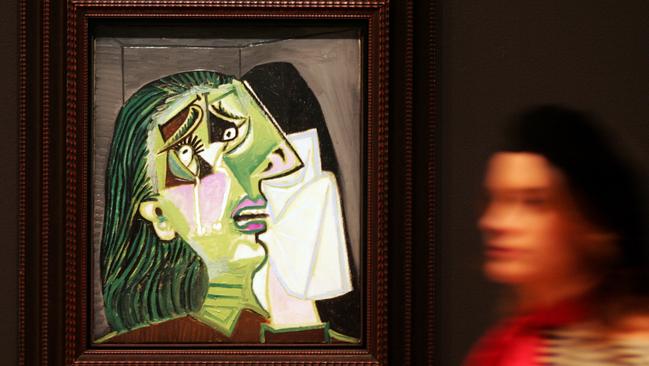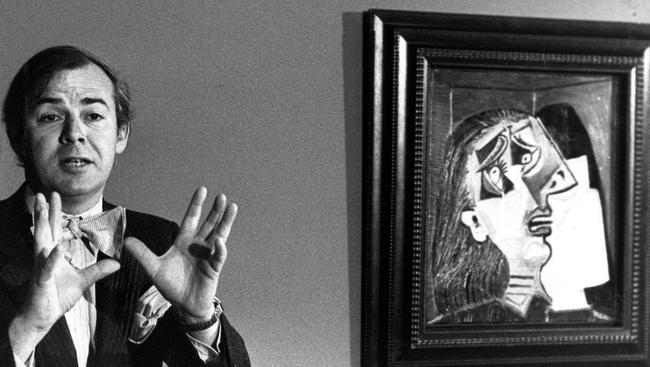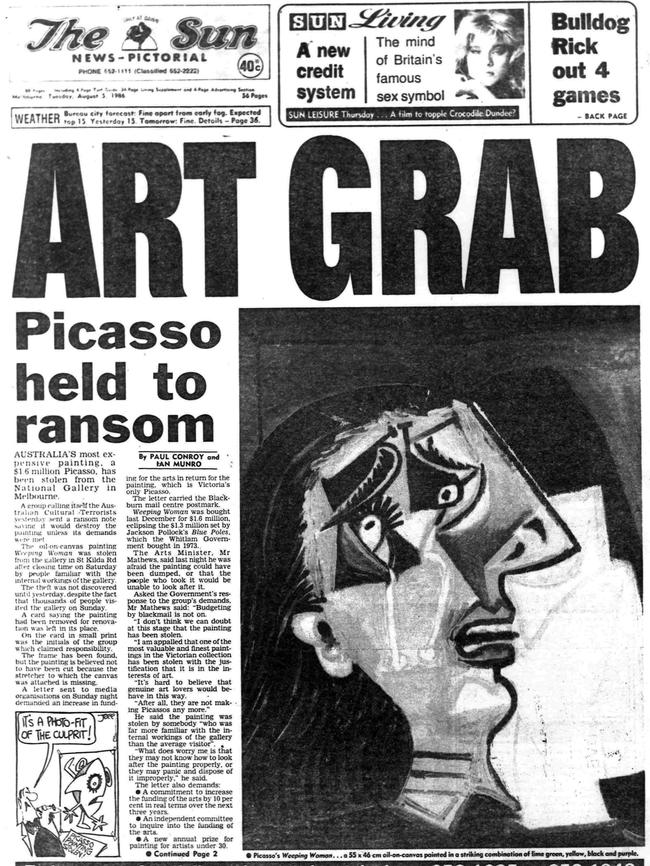Picasso’s Weeping Woman the most brazen art robbery in Australian history
PABLO Picasso’s Weeping Woman was the most expensive painting ever bought by an Australian art gallery. Then it was stolen, sparking a frenzied search. The thieves were never caught.

Cold Cases
Don't miss out on the headlines from Cold Cases. Followed categories will be added to My News.
PABLO Picasso’s Weeping Woman was the most expensive painting bought by an Australian art gallery when the National Gallery of Victoria forked out $1.6 million in 1985.
Gallery director Patrick McCaughey said at the time of the purchase of Weeping Woman that it would “haunt Melbourne for the next 100 years”.
It certainly came to haunt him.
Just months after it took pride of place on the gallery wall, the painting was gone.
All that remained was an empty frame and a typed note from a group calling itself the “Australian Cultural Terrorists”.
The biggest art heist in Victoria’s history has never been solved and the culprit (or culprits) never caught.

True Crime Australia: Lost art of the bush tracker
True Crime Australia: $3 million in rewards for cold cases
Weeping Woman was painted by Picasso in October 1937, not long after he completed his greatest work, Guernica. The painting is one of a series of the same woman; the definitive version hangs in London’s Tate Gallery.
The theft from the NGV is believed to have occurred on Saturday, August 2, 1986. But went unnoticed for at least a day.
It did not become public until two days after the painting vanished, when The Age newspaper received a letter addressed to then-arts minister Race Mathews that read: “We have stolen the Picasso from the National Gallery as a protest against the niggardly funding of the fine arts in this hick State.”

The paper phoned the gallery and it was confirmed that the most expensive painting in the nation was gone.
“The security controller and I shot down to the European galleries. The Picasso was indeed gone but in its place was a registrar’s card noting that the painting had been removed to the ACT. The card had been there all the previous day and disguised the theft from the guards, who assumed the work was going on loan to the National Gallery in Canberra,” Mr McCaughey said in his book The Bright Shapes and the True Names.
“Confronting the bare wall and the fake label, I was aghast. I excused myself from the committee meeting and began a search of the gallery, desperately hoping that it was a prank and that the painting had been hidden in the building.’’
A statement from the gallery said the Picasso was removed from the wall with a special security screwdriver but McCaughey dismissed the rumours that the theft was an inside job.
A frantic all-night search failed to find anything more than the empty frame of the painting near where it was removed from a gallery wall.


It was believed there was still a faint chance that the painting could be hidden in the building and police spent days scouring every part of the gallery — in vents, behind other paintings, anywhere that it could possibly be hidden.
Victoria’s crack Major Crime Squad was called in to handle the investigation.
The next day the government made it clear it would not negotiate with the thieves and said a ransom would not be paid.
On August 11 the hunt for the missing painting took an ominous turn when the group claiming to have stolen it sent a letter and a burnt match, which read: “thank you for your support. Phase two begins shortly.”
Then there was silence from the thieves for almost two weeks. Fingers were pointed and the media developed theories about who stole the painting.
There was a consensus that it was an inside job — someone who knew the intricate workings of the gallery and its security arrangements.
Then on August 19 The Age received a call saying the painting was in locker 227 at Spencer Street Station.

Mr McCaughey recounted in his memoir: “When I got to locker 227, Age journalist Magaret Simons was the only person there. She had already tried the locker but it was - surprise, surprise - locked.The police did not show up for another hour. Gradually a sizeable crowd began to assemble around locker 227.
“Television news crews and other reporters got wind of the story and showed up in force. The police arrived, told everybody to stand back and summoned an assistant station master, who jemmied it open. The police beckoned me to look inside and there was a brown paper package exactly the dimensions of Picasso’s Weeping Woman. The gallery’s chief conservator, who was now on hand, whipped the package into a waiting police car with journalists running after us. We were whisked up to the forensic laboratory where the painting was unpacked and Weeping Woman emerged unharmed.’’
Race Mathews was confident the culprits would be found.
“I would find it extraordinary if nothing were to surface from a world which is characterised so much by the exchange of gossip and strongly felt rivalries,” he said after the painting was recovered.
To this day, no one has ever been charged with the theft of the Weeping Woman.
Originally published as Picasso’s Weeping Woman the most brazen art robbery in Australian history
